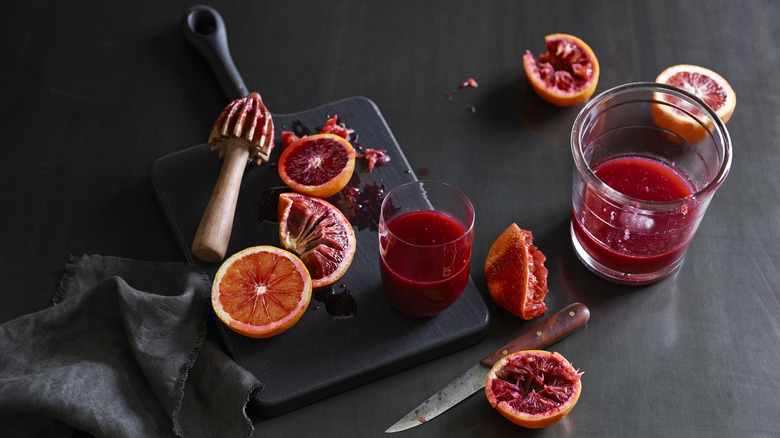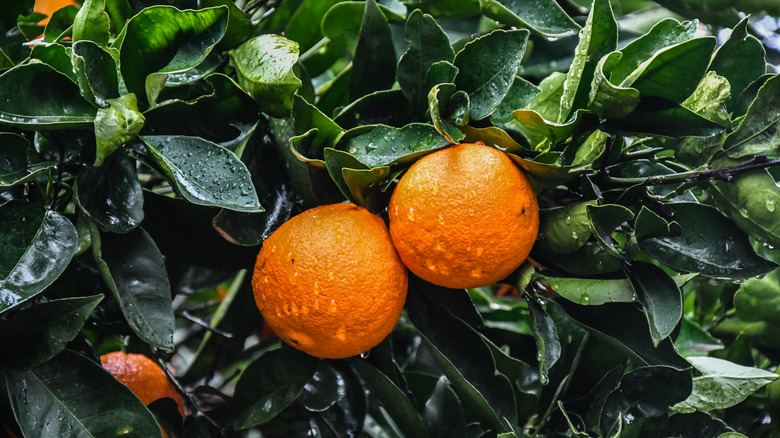Blood Orange Vs. Navel Vs. Cara Cara: How Do They Differ?
Whether they're zested over a cake or piled in a bowl for easy snacking, oranges are a fan favorite in the citrus world, with varieties ranging from standard navels to pink-hued Cara Caras to deep-scarlet blood oranges. All of these are different types of the same fruit, but what exactly sets each kind apart?
First, a quick primer on the orange. Native to Asia, today's "sweet oranges," as they're commonly called, descend from a cross between pomelos and mandarins. The fruit spread across Europe and then the New World, where the first seeds arrived via Christopher Columbus' ships. Here, they became not just a major source of vitamin C but also big business: By 1920, oranges were the second-biggest moneymaker in the whole state of California, second only to oil.
The navel orange became, and remains, one of the most popular kinds — your classic orange. Once it gained a foothold in growers' orchards, it spawned the Cara Cara, a low-acidity, subtly pink type of navel orange. The blood orange, meanwhile, isn't a navel at all. Rather, it comes from the Mediterranean region (maybe Sicily) and is characterized by its sweet-tartness and dramatic color. Here's a little more on each.
What is a blood orange?
Out of all the citruses, the blood orange is surely one of the most surprising to peel: What looks pretty normal from the outside (the rind is orange, after all) opens up to reveal richly hued scarlet flesh. That coloring is due to an antioxidant called anthocyanin, which provides pigmentation to various plants. For blood oranges, it's only activated when the fruit is exposed to sufficiently cold temperatures, either while it grows or after it's harvested. Blood oranges' finickiness with temperature may be why they remain a somewhat niche product, as they can be tough to grow. But the presence of anthocyanin means that while the blood orange provides benefits you get with other oranges — most notably vitamin C — it also gives you that added antioxidant boost.
The blood orange is a mutation of the sweet orange, tinged with berry notes and an edge of bitterness. This fruit's color makes it a natural for salads, where it adds a sweet-sour element in addition to that bright scarlet pop. Its coloring also looks amazing in mimosas, margaritas, and other desserts and cocktails (which you could garnish with a dried blood orange slice, if you're fancy). They're basically great anywhere you'd use a navel orange — after all, the two are quite similar, color aside. And as with most oranges, they're also pretty great to snack on.
What is a navel orange?
If you've ever eaten a navel orange, you probably know how it got its name: the nubby little bump that grows at one end. Originating in Brazil, navels are basically the classic eating orange. Their thick skin is easy to peel, they're seedless, their zest is perfect for baking, and they're juicy enough, though they're not exactly great for juicing — that honor goes to the Valencia orange, generally regarded as the best juice orange. Navel oranges' "navel," by the way, is also the result of a mutation — in this case, it's actually a second, much smaller orange that fused with the larger fruit and failed to grow further.
While navel oranges themselves might be pretty standard, their history is anything but: The first person to successfully grow a navel orange tree in the United States was Eliza Tibbets, a Cincinnati-born 19th-century suffragist and abolitionist who planted two of the trees at her home in Riverside, California in 1873 using cuttings she received from Brazil. She's even said to have irrigated her trees with dishwater.
Three decades later, the Riverside County orange crop was worth about $3 million annually, and California's "second gold rush," as some have called it, was on. Now navels are the dominant orange in the U.S., all descended from Tibbets' pair of trees. Fun fact: One of those two original orange trees nurtured by Eliza Tibbets still lives, and it's a California state landmark.
What is a Cara Cara orange?
The Cara Cara orange is increasingly a staple of grocery produce sections, and thank goodness for that: With its low acidity, the Cara Cara is sweeter than a navel orange but also has some intriguing floral notes (though some have compared the taste to red berries). This orange's lovely flavor is complemented only by its blushing pink color, both properties that make the Cara Cara orange a favorite of chefs. The coloration comes not from anthocyanin, like the blood orange, but from lycopene, another antioxidant. The same stuff that gives tomatoes their hue, lycopene has been lauded for its heart-healthy, anti-inflammatory potential. A thinner-skinned type of navel orange, Cara Caras also have more vitamin C and more vitamin A than the plant from which they descend — in short, they're a bit of a nutritional powerhouse.
Cara Cara oranges are a relatively recent addition to the citrus family: They emerged in Venezuela in the 1970s as a happy accident, a mutation on another type of navel orange tree that happened to turn into something both beautiful and delicious.



